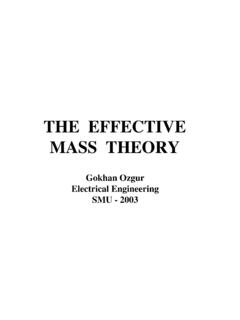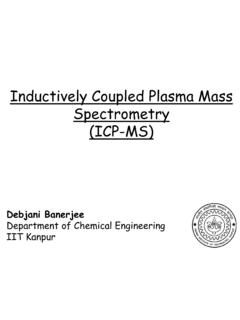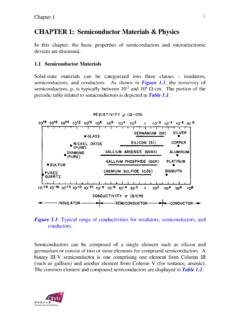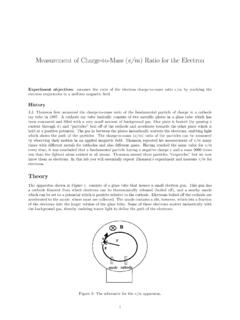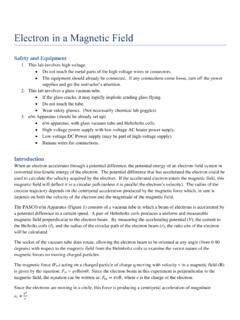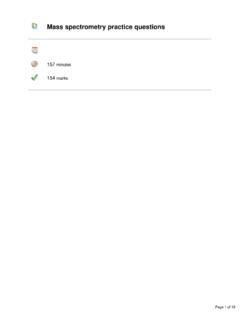Transcription of Experiment 4: Charge to mass ratio (e/m) of the electron
1 INTRO TO EXPERIMENTAL PHYS-LAB 1494/2699 Experiment 4: Charge to mass ratio (e/m) of the electron Nate Saffold Office Hour: Monday, 5:30PM-6:30PM @ Pupin 1216 PHYS 1493/1494/2699: Exp. 4 e/m of the electron2 Introduction Our first measurement of atomic structure Charge -to- mass ratio of electron : Motivation and history of the first e/m measurement Consequences Thomson s Experiment The physics behind the Experiment : The magnetic field generated by a single loop Charged particle in constant magnetic field Measurements: Preliminary set-up: ambient magnetic field Measure Charge -to- mass ratio by bending electron through constant magnetic fields Analysis3 Why measure e/m? Prior to this measurement (~1897), what did we know about matter? ANSWER: Very little! We understood the classical macroscopic forces between matter: Gravity: Electromagnetism: Maxwell's equations Coulomb and Lorentz forces: Nobody really knew what the constituents of matter were.
2 Or if there were any!PHYS 1493/1494/2699: Exp. 4 e/m of the electron4 What is matter? What is matter really made of? Infinitely divisible ( continuous matter)? Made up of individual constituents? Thomson provided experimental evidence of the existence of discrete constituents of matter: He showed that matter has constituents that are negatively charged and whose Charge / mass ratio is constant This suggests that Charge is not infinitely indivisible but comes in corpuscles ( electrons) This is the first example of quantization (existence of discrete components) of nature!(Awarded 1906 Nobel Prize)I might look grumpy but at least I have a Nobel 1493/1494/2699: Exp. 4 e/m of the electron5 Consequences This led Thomson to postulate the plum pudding model:Quanta (electrons) enclosed in a continuous positive distributionPHYS 1493/1494/2699: Exp. 4 e/m of the electron6 Consequences This led Thomson to postulate the plum pudding model: Nice too bad it is completely Rutherford scattering experiments (1911): Matter is made of compact localized nuclei Development of Quantum Mechanics (1920's): The microscopic constituents of matter follow novel and surprising laws of physics!
3 Quanta (electrons) enclosed in a continuous positive distributionPHYS 1493/1494/2699: Exp. 4 e/m of the electron7We're not done yet! Several experiments suggest that electrons might indeed be elementary, indivisible particles However nucleons (protons or neutrons) are not! 1968: Scattering experiments at the Stanford Linear ACcelerator (SLAC) show that nucleons are made of more fundamental particles: quarksPHYS 1493/1494/2699: Exp. 4 e/m of the electron8We're not done yet! Several experiments suggest that electrons might indeed be elementary, indivisible particles However nucleons (protons or neutrons) are not! 1968: Scattering experiments at the Stanford Linear Accelerator (SLAC) show that nucleons are made of more fundamental particles: quarks This led to the development of the Standard Model of elementary particlesPHYS 1493/1494/2699: Exp. 4 e/m of the electron9We're not done yet! Several experiments suggest that electrons might indeed be elementary, indivisible particles However nucleons (protons or neutrons) are not!
4 1968: Scattering experiments at the Stanford Linear ACcelerator (SLAC) show that nucleons are made of more fundamental particles: quarks This led to the development of the Standard Model of elementary particles In 2012 the last piece of the puzzle completes the pictures! And now? What s next? Is it possible to go even further?Sorry I m late!(Peter Higgs)PHYS 1493/1494/2699: Exp. 4 e/m of the electron10 Single loop magnetic field Recall the Biot-Savart Law:Line integral over the wirePHYS 1493/1494/2699: Exp. 4 e/m of the electron11 Single loop magnetic field Recall the Biot-Savart Law: A single ring of wire will generate a field following the right hand rule and with magnitude on the ring axis:Line integral over the wirePHYS 1493/1494/2699: Exp. 4 e/m of the electron12 Single loop magnetic field Recall the Biot-Savart Law: A single ring of wire will generate a field following the right hand rule and with magnitude on the ring axis:R = radius of the loop z = height from the plane of the loopLine integral over the wirePHYS 1493/1494/2699: Exp.
5 4 e/m of the electron13 Circular motion of Charge in B field The second ingredient we are going to use is the motion of a Charge experiencing a constant magnetic field Last time (exp. 3) we saw that a particle of Charge q, entering a region of space with constant B field at a velocity v feels a Lorentz force: Since velocity and force are perpendicular to each other the motion will be circular In particular, the centripetal force must be provided by the Lorentz force itself and hence:PHYS 1493/1494/2699: Exp. 4 e/m of the electron14 Circular motion of Charge in B field However, measuring the velocity of an elementary particle is a very non-trivial business A simple solution to this problem is to speed the electrons up thanks to a known potential difference ( generated by two plates with opposite Charge ) In this case conservation of energy tells us that: Combining it with the previous result, we can eliminate the velocity from the equation:PHYS 1493/1494/2699: Exp.
6 4 e/m of the electron15 The ExperimentPHYS 1493/1494/2699: Exp. 4 e/m of the electron16 Main goals The equipment: Helmholtz coils: provide magnetic field Cathode ray tube: provides electron beam Measuring rods: allow to measure the radius of the circular motion The Experiment : Alignment of experimental apparatus with the ambient magnetic field BE Preliminary measure of BE Bend electron beam with magnetic field and measure e/mPHYS 1493/1494/2699: Exp. 4 e/m of the electron17 Apparatus For this Experiment : Use two coils with current Cathode ray tube centered in between Helmholtz coils Generate the magnetic fieldElectrons will appear in hereMetallic comb used to measure rPHYS 1493/1494/2699: Exp. 4 e/m of the electron18 Helmholtz coils (uniform magnetic field) For this Experiment : Use two coils with current PHYS 1493/1494/2699: Exp. 4 e/m of the electron19 Helmholtz coils (uniform magnetic field) For this Experiment : Use two coils with current For this setup we need the magnetic field at the center of the Helmotz coils (z = R/2): Calculate constant C from R and N!
7 This represents magnetic field at center of experimental apparatus. (Location where cathode ray tube will sit)PHYS 1493/1494/2699: Exp. 4 e/m of the electron20 How to manage the magnetic field The power supply for coils and filament looks like:Coil current adjust knob (changes the current flowing in the coils)AmmeterCoil current reverse (changes the direction of the current and hence of the B field)PHYS 1493/1494/2699: Exp. 4 e/m of the electron21 Preliminary alignment The equipment: Helmholtz coils: provide magnetic field Cathode ray tube: provides electron beam Measuring rods: allows to measure the radius of the circular motion The Experiment : Alignment of experimental apparatus with the ambient magnetic field BE Preliminary measure of BE Bend electron beam with magnetic field and measure e/mPHYS 1493/1494/2699: Exp. 4 e/m of the electron22 Aligning to environment magnetic field Even without any current the electron will still experience the ambient magnetic field BE (Earth, nearby magnets, etc.)
8 We want to minimize and estimate this effectPHYS 1493/1494/2699: Exp. 4 e/m of the electron23 Aligning to environment magnetic field Even without any current the electron will still experience the ambient magnetic field BE (Earth, nearby magnets, etc.) We want to minimize and estimate this effect By rotating the Helmotz coil we can bring BI and BE parallel to each other Therefore:PHYS 1493/1494/2699: Exp. 4 e/m of the electron24 To fully determine the magnitude of the ambient magnetic field we need to align the Experiment to BEAligning to environment fieldPHYS 1493/1494/2699: Exp. 4 e/m of the electron25 To fully determine the magnitude of the ambient magnetic field we need to align the Experiment to BE Procedure: Use compass Place compass flat horizontally Rotate coils to align with . Needle must be on 90 or 270 degreesAligning to environment fieldPHYS 1493/1494/2699: Exp. 4 e/m of the electron26 Aligning to environment field To fully determine the magnitude of the ambient magnetic field we need to align the Experiment to BE Procedure: Use compass Place compass flat horizontally Rotate coils to align with.
9 Needle must be on 90 or 270 degrees Rotate compass vertically Rotate Experiment to align with . Needle must be on 0 or 180 degrees Now your Helmotz coil is nicely aligned with the ambient field!PHYS 1493/1494/2699: Exp. 4 e/m of the electron27 Make sure to align horizontally before you align vertically. Reading compass needle: When aligning, needle will oscillate! Wait until compass needle has stopped oscillating (maybe help reduce the oscillations with your hand) to determine if experimental apparatus is aligned Tip: Wait about 30 seconds before determining if it's aligned. Parallax errors: Once again, try to be careful and consistent in eye alignment with compass needle This preliminary set up is really important. Once you re done ask your TA to check that everything is fine!Aligning to environment field: tipsPHYS 1493/1494/2699: Exp. 4 e/m of the electron28 After you completed your alignment procedure the whole apparatus should look like:Aligning to environment field: tipsRotated to align with the horizontal component of BERotated to align with the vertical component of BECompass is herePHYS 1493/1494/2699: Exp.
10 4 e/m of the electron29 Preliminary measure of BE The equipment: Helmholtz coils: provide magnetic field Cathode ray tube: provides electron beam Measuring rods: allows to measure the radius of the circular motion The Experiment : Alignment of experimental apparatus with the ambient magnetic field BE Preliminary measure of BE Bend electron beam with magnetic field and measure e/mPHYS 1493/1494/2699: Exp. 4 e/m of the electron30 Adjusting voltage on heated filament Same power supply as Helmholtz coilsVoltmeter measure voltage potential on the filament that ejects the electronsVoltage adjust knobFilament potential reversalPHYS 1493/1494/2699: Exp. 4 e/m of the electron Turn Helmholtz coils off : Note that the beam will be curved anyway Set the Helmholtz coil current gain setting to 200mA Using the coil reverse switch and current adjustment knob , determine the current needed to make the beam trajectory straight When the beam is straight it must be BI = BE Determine BE (with errors!)











